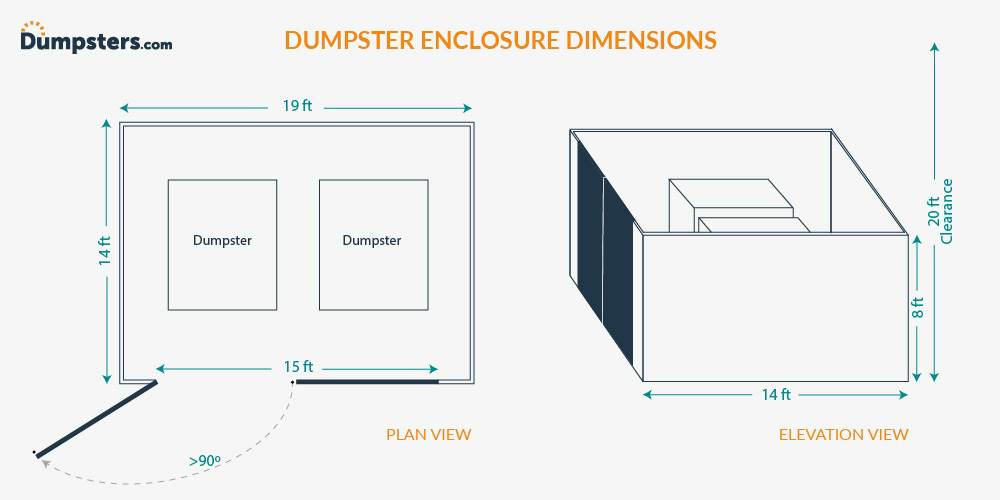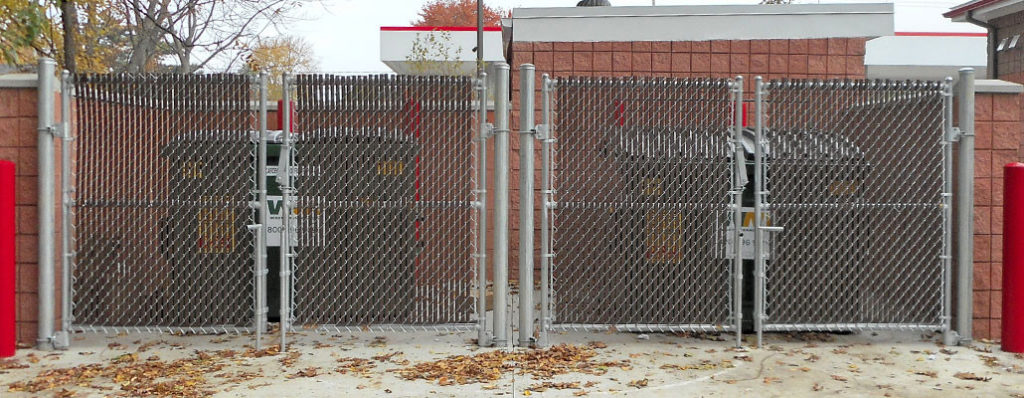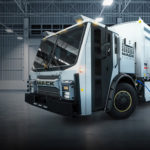A good dumpster enclosure is necessary to keep your dumpsters safe from unwanted garbage in your bins.
But what exactly is a dumpster enclosure?
A dumpster enclosure is a fenced-in area that allows you to hide your temporary or commercial container from view.
This is so you can keep your property looking clean and presentable.
It will also prevent trash from being picked up by the wind, animals from getting into your bin, and strangers from illegally dumping in your container.
All of these things could cause you to rack up extra fees.
Although building one is a bit costly, your bins are better off hidden from your customers.
This is because many people see them as their own personal dumping ground to take out their own trash on business property.
Or, animals like raccoons and coyotes can find your trash appetizing which can cause hazardous problems for your business.
Not to worry, building a dumpster enclosure can help with these problems, and it isn’t difficult.
We’re here to show you how.
Steps To Build An Enclosure.
When you’re ready to build a dumpster enclosure, it helps if you go in with a plan.
Use these steps to choose the right material for your enclosure.
Then always make sure you have enough space and successfully build your fence.
The last thing you want to do is go into the project not feeling confident or ready.
Here are some considerations to keep in mind as you prepare to build your enclosure and pick a design.
1. Choosing A Material.
Dumpster enclosures can be made out of several different materials.
The chart below shows some pros and cons of each to help you choose.

Some cities require enclosures to be made out of a specific material.
Check the regulations in your city or state by finding your local Building Department’s website or giving them a call.
But what will the cost be for your enclosure?
Well, The cost of your dumpster enclosure will depend on the following factors:
- The material you choose to use for your enclosure.
- Whether there’s an existing concrete foundation on the property for the dumpster to sit on.
- The number of dumpsters on your property.
- Whether you plan to build the enclosure yourself or hire a pro.
So picking the materials for your project is the first step to creating your own dumpster enclosure.
2. Determining Dimensions.
The dimensions of your enclosure need to account for the size of the dumpster.
Not only that, but it needs to leave enough room for employees to use your bin and for a garbage truck to pick it up.

Dumpster enclosures can be built with a variety of dimensions, but use the table below as a general starting point.
Some cities require their own dimensions for dumpster enclosures.
Check with your local Building Department to find out if any rules apply in your area.
However, here are the minimum dimensions that your enclosure should be:

Deciding the dimensions for any project is important if you want the results that you’re expecting.
3. Installation Method.
It’s tempting to just put up your enclosure yourself, but it may end up costing more in the long run if you make mistakes.
Some types of dumpster enclosures are better candidates for DIY installation than others.

If you’re building with simpler materials such as wood or vinyl, doing it yourself may be the best choice for you.
But, if you’re using more expensive materials, you might want to consider hiring a pro that can do the work for you.
That way, there will be less mistakes made if something were to go wrong in the building process.
Plus you’ll want to build your dumpster enclosure on a parking lot or other concrete surface.
Keep in mind that if you choose DIY installation you’ll need to rent a hammer drill to create post holes.
Whatever surface you’re building your fence on, you’ll need to mix and pour concrete to make the posts sturdy.
If you’re not up for either of those tasks, choose pro installation no matter what type of enclosure you’re building.
It’s much more cost-effective to get it done right than to build a flimsy fence that can’t stand repeated use.
4. Post Holes.
Post holes are an important part of the enclosure to make sure that the gates stay shut when you’re done taking out the garbage.
Here are the steps to making a post hole yourself:
- Use a string line to mark the perimeter of your fence.
- Determine where the posts will go. Mark where the center of each post will sit.
- Measure the width of your fence posts. Multiply that number by 3. This gives you the diameter needed for your post holes.
- Draw a circle with the proper diameter around each of the center-post marks.
- Drill holes about one inch apart around the perimeter of each circle using a hammer drill. Then drill several holes within the circle. This’ll prevent cracks from forming in the surrounding concrete during the next step.
- Switch to a chisel drill bit. This turns your hammer drill into a small-scale jackhammer to begin breaking up the concrete within the circle.
- Once all the concrete has been broken up and removed, use a post hole digger to create a hole 24 inches deep.
- Add a few inches of gravel to the hole for drainage.
- Repeat steps 6-8 for each post.
Follow these steps if you’re looking to put in your own post holes for your enclosure.
Also, make sure to contact your local digging company to make sure you’re not in danger of hitting utility lines.
This protects you from potential injury and extremely costly damages.
5. Final Tips.
Here are some final tips for you when you’re putting in your dumpster enclosure:
- Make sure to get a permit from your city to be able to build a dumpster enclosure in the first place.
- Place your dumpster at least 50 feet from your building. If space allows, go for at least 100 feet from the closest entrance. Keep in mind that this may affect the dimension requirements for your enclosure.
- For temporary dumpsters, It’s a good idea to place a locked, temporary fence around a roll off dumpster or your job site. This is so you can work through a construction project or home remodel to keep unwanted guests from using your container.
To Conclude.
A good dumpster enclosure is necessary to keep your dumpsters safe and clean from unwanted garbage in your bins.
An enclosure is good to keep people from dumping illegally, animals getting into your garbage, and makes dumping the garbage easier for garbage trucks.
So, if you’re looking for a reason to have a dumpster enclosure on your property, these are the reasons why.
Credit: https://www.dumpsters.com/blog/building-a-commercial-dumpster-enclosure#choose-a-material



